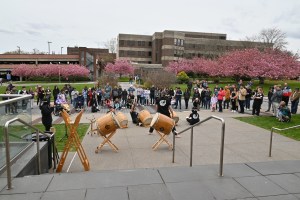Standing behind a podium in a second-floor conference room at the Bay Park Sewage Treatment Plant, Nassau County Executive Ed Mangano laid out his plan for the potential privatization of the county’s $1.3 billion sewer system to an intermingled crowd of about 60 residents and sewage workers.
It was the same pitch he’d made one week before, to roughly 100 people packing a steamy meeting room inside the Cedar Creek Water Pollution Control Plant in Wantagh. The same spiel Mangano cast to reporters May 3 when he called a news conference to announce the selection of New Jersey-based United Water as the county’s pick to lease, operate and maintain its three wastewater treatment plants. The very same sell he made May 17 at the Theodore Roosevelt Executive and Legislative Building, the last stop on a three-public-information-session tour.
Here’s Mangano’s talking points:
The county’s New York State-mandated fiscal control board, the Nassau Interim Finance Authority (NIFA), foretells of an impending sewer fund deficit in 2014. Such a public-private partnership, or “P3”—which the selection of United Water was merely the first part—is the most logical option to deal with that looming deficit to date. The second phase, the selection of an as-yet-unnamed financier, or “concessionaire,” would give the county a $750 million to $850 million upfront lump sum payment based on a 50-year arrangement and fund $300 million to $400 million in capital improvements throughout the next decade to bring the facilities up to snuff. United Water would ensure those repairs and upgrades were made and county sewage workers won’t lose their jobs. Sewer rates would be frozen through 2015 and capped at the Consumer Price Index going forward, which averages about 3 percent annually. The deal would pay down a large portion of the county’s $3 billion debt and thus create recurring revenues.
The alternative to his “Debt Reduction and Sewer Stabilization Plan,” Mangano has warned at each of his sessions, would be a 22 percent rate hike in 2014 and 10 percent bump each year going forward.
It was the third time Mangano made the same speech directly to the public. The difference with this venue was that it was Bay Park, a community that had been lied to and literally dumped on for decades by glad-handing politicians and county officials. The day of Mangano’s visit, the plant was in fact running on loud, tractor-trailer-sized diesel generators that had been hastily hooked through the plant’s walls as a Band-Aid to bypass what has been an unprecedented power failure; the neglected facility made regional news in 2010 when brown plumes oozing from its discharge pipe into popular fishing and recreational grounds made it onto YouTube. The county was fined $1.5 million by state regulators in relation to those illegal excretions.
No, Bay Park residents wouldn’t be going along with Mangano’s plan without getting some answers first.
Among those they sought: “How many health, safety and environmental violations or criminal charges has United Water received from state or federal regulation-enforcement in the last five years? What was the most serious?”
Fielding it was Brent Fewell, the company’s vice president of environmental compliance.
Sporting a red-and-white striped bowtie, he introduced himself as a former EPA regulator. He talked about the 230 violations Nassau’s plants had received. He said how surprised he was that the EPA hadn’t taken action sooner. He explained how dedicated his company was to compliance.
“Answer the question,” grumbled a man from the crowd.
Fewell continued, stressing the importance of training plant operators to know the environmental laws.
“I don’t think you answered the question,” interrupted the man a few moments later, louder.
“I’m sorry?” asked Fewell.
“You’re not answering these questions,” he replied. ”We didn’t ask you about our plants.”
“So one of the questions was: Who is United Water, what’s this criminal matter that we heard about, in Gary, Indiana?” responded Fewell. “This is a matter that’s of public record. Many of you have probably read about it. It is a very technical legal issue involving facts that occurred over 10 years at one of our plants, our operators in Gary, Indiana. We feel very strongly that the government is wrong.
“I’m not going to go into it, again, that’s of public record, you can go online, you can read the pleadings in that case,” he said, following a woman’s declaration that she had a “list of questions” regarding United Water’s track record across the country. “There is no allegations of any environmental harm in that case, no allegations of violations. It is a very technical, legal question. We believe, and as a former regulator, I believe, the Department of Justice is wrong in this case. And we’re going to take it to trial.”
What Fewell struggled to articulate was that his company, United Water—a subsidiary of Paris, France-based water giant Suez Environnement—was the subject of a criminal investigation by the Northern District of Indiana Environmental Crimes Task Force, Criminal Investigation Division of the U.S. Environmental Protection Agency, the FBI and the Indiana State Police, regarding its former operations in Gary, Indiana. The company and two of its top employees from that operation are currently the subjects of a criminal case stemming from that probe, being prosecuted by the U.S. Attorney’s Office for the Northern District of Indiana and the Justice Department’s Environmental Crimes Section, charged by a federal grand jury with 26 felony counts including conspiracy and violations of the Clean Water Act—the federal law regulating the discharge of pollutants into waterways and quality standards for surface waters.
A report by the nonprofit Food & Water Watch, United Water: Suez Environnement’s Poor Record in the United States, documenting alleged misdeeds and mishaps at nearly a dozen other operations throughout the country, was circulating at each of Mangano’s public pitches. It paints a portrait of financial and environmental recklessness, to say the least. United Water officials confidently dispute the group’s claims.
Mangano’s sewer privatization proposal, the subject of a Press investigation in November and the continuation of an award-winning investigative series into the state of Nassau County’s troubled sewage system that began in 2005, has been panned by economists, legal experts, environmentalists and community watchdogs and nonprofit think-tanks, including academics from several of the nation’s top universities. Earlier this month, NIFA, which seized control of the county’s finances last year and has final say over all county contracts totaling more than $25,000, unanimously rejected a contract with investment giant Morgan Stanley worth up to $5 million critical to making the plan a reality.
As Bay Park residents’ curiosity exemplifies, there is still very much the public does not know regarding the details and mechanics of Mangano’s plan; from its choice for private operator, United Water, to its yet-to-be selected private investor, to exactly how much ratepayers will be paying to flush their toilets for the next 50 years, among others. Even Nassau County Comptroller George Maragos hasn’t seen any official proposal yet, his spokesman Jostyn Hernandez tells the Press.
Several things are certain, however: It would be the largest such financial transaction in the county’s history, the state and one of the largest in the country. It would absolutely determine the fate of generations of Nassau County taxpayers’ dollars. It is also moving full-speed ahead, no matter what.




























